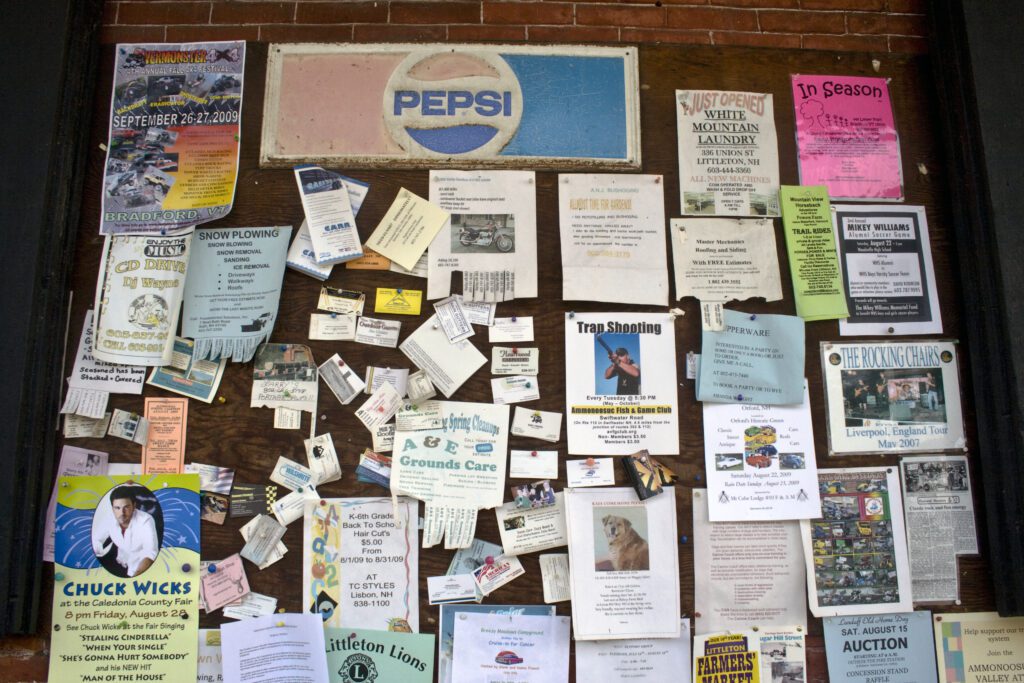Challenger Food Brands and the Business-card-sized Poster

I can remember my first encounter with marketing materials from our local independent hardware shop. While still a student at the nearby university, I glanced at a campus bulletin board on the third floor of an anonymous campus office and saw, tacked among the posters for campus theatre productions, a black-and-white business card with a phone number handwritten on it. The quirkiness and audacity of tacking up a business card on a crowded, obscure bulletin board and expecting it to compete with glossy, university-produced posters caught and held my attention.
Although I’ve never actually patronized the shop (mainly because it’s not all that near my home), I continue to take note of their marketing: I rode by the shop this morning and observed that, in addition to customer parking on the street, they’ve added a series of paintings depicting customers to the exterior of the building.
I admire that hardware shop, not only for their quirky marketing but because they seem to be thriving in an environment that doesn’t favor independent shops. With the growth of hardware store chains and the much larger home improvement superstores, times are tough for local shops, and achieving success in the face of the lower prices and greater awareness of the chains takes some real creativity.
The situation in the food industry is more analogous to hardware stores than one might think. Despite greater consumer awareness of heirloom foods, niche producers, and trendy independent restaurants, a recent study showed that America will soon be a country of more chain restaurants than independents. Where real estate prices or wages increase, chains have an advantage—leading to a future where they are expected to dominate the American foodservice landscape. Meanwhile, in the world of food processing, major brands are having a harder time—recent splits and acquisitions come to mind—but they still own more of the average grocery store than artisanal brands.
So what’s a challenger to do in a situation like this, whether a local hardware store, a mom-and-pop restaurant, or a startup food processor? If I were feeling more viral, I’m sure I could come up with 17 or 23 tips—and indeed, successful branding does require consideration of the whole environment—but there’s really only one factor I’m interested in here, and it’s one that local hardware shop has in spades (sorry): personality.
Chain restaurants and other major brands have a number of advantages over the challenger, but one of the most important where food is concerned is familiarity. Food and the eating experience are deeply personal, and unfamiliarity with the menu or the ingredients makes us all uncomfortable on some level. Consumers already have a relationship with large brands even if they haven’t patronized them, whether through advertising or simply seeing their products on the shelf. To combat that advantage, challengers need to develop a relationship of their own with consumers.
The best path for a new brand to developing a relationship with consumers is through a strong personality. Although brands with strong personality may not have the broadest appeal, they are most likely to inspire interest and even love. Playing it safe or going basic can’t do that—better to establish a strong voice with a more narrow appeal than to create a broad brand that lacks personality. Like the hardware store, it’s crucial that your challenger food brand possess a voice and personality that consumers can learn to love—business-card-sized posters not required.
At MarketPlace, we have experience with the full range of food brands, from global ingredient brands to startups. Whether established brand or challenger, we turn our food branding expertise to make sure that our clients have compelling and appealing brand personalities. If you need help establishing a great brand personality or competing in a challenging market, get in touch today.
